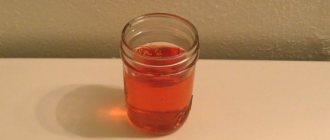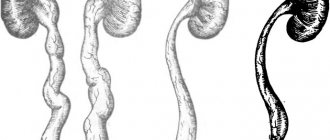Author of the article
Pastushok Vladimir Georgievich
Practicing nephrologist, experience over 11 years
Articles written
27
Contact the author
Doctors can determine what disease a person is suffering from by analyzing urine, its consistency and color. In healthy people, urine is clear and yellow. But purple urine raises many questions; it is quite unusual and incomprehensible and indicates existing problems in the body.
Causes
- Use of medications:
Most antibacterial drugs tend to affect the color of urine. In very rare situations, it can take on a blue or purple hue. Some products intended for diagnostic purposes can also be excreted in the urine, changing its color to purple.
There is such a pharmacological agent as Cycloferon, it is an immunostimulating, antiviral and anti-inflammatory drug with a wide spectrum of action. Many people use cycloferon for the prevention and treatment of viral diseases, and it is also prescribed to animals. But after the first use, especially in injection form, many people have observed blue or purple discharge, even in animals. If you carefully read the instructions for using cycloferon, it may indicate such an effect as a change in the color of urine to a purple tint.
- Ingestion of foods that can color urine;
Sometimes purple urine can be released due to a violation of the metabolism of the amino acid streptophane, and foods with a large amount of it cause the accumulation of the latter, and as a result, a change in the color of the urine. These products include: legumes, cheeses, meat products, some types of fish, etc.
- One of the more well-known causes is called ''Purple Bag Syndrome''
It was first described in 1976; today this syndrome has already been well studied, and it is considered more or less frequent and dangerous. This color when urinating should concern both the doctor and the patient.
Tryptophan enters the human body with consumed food, more than half of it is used to produce serotonin, and the remainder is collected in the intestines. There, the local microflora converts tryptophan into indole, which in turn enters the liver and combines with acids there to form non-toxic Indican.
Indican is excreted from the liver into the circulation and retained in the kidneys as waste. If at this moment there is an infection of the genitourinary system, bacteria that should cleave sulfuric acid from indican convert it into indoxyl.
The alkaline environment promotes microflora to transform indoxyl into indigo with a blue tint and indirubin with a red tint. When these substances mix together, urine turns purple.
Pathogenic factors
Pathological causes
There is a single pathological reason why purple urine occurs - “purple sac syndrome”. This is a relatively common and serious condition that should be of concern to both patient and physician. An amino acid called tryptophan enters the body with food, and part of it is processed into a biogenic amine - serotonin. The excess remains in the intestines. After this, indole is formed by processing this amino acid with microflora bacteria. Penetrating into the liver, indole, together with acids, forms a safe indican.
Why does urine change color?
If a person is completely healthy, or he does not have problems with the genitourinary system, then his urine will have a light yellow color, sometimes with slight deviations in shades. When you consume a sufficient amount of liquid, preferably plain water, it will have a straw color, but if its color becomes bright and more saturated, it means that the body is not receiving enough liquid.
A change in urine color may indicate a bacterial infection. In the human body, many metabolic processes occur, as a result of which the actual metabolic products that have a certain color are released. Most of them are excreted in the urine.
In addition, there are other reasons for urine turning blue, namely:
- the presence of specific parasites in the body;
- sexually transmitted diseases;
- medication use;
- eating plant foods;
- bacterial infection.
Discoloration of urine is considered a side effect of medications, but it does not affect the general condition of the patient. Very often, a blue color is observed after consuming Cycloferon and methylene blue.
After discontinuation of Cycloferon, urine color normalizes
If there are disturbances in the internal organs in the human body, then accordingly changes occur in metabolic processes, resulting in the formation of decay products, which color the urine in an unusual color. One such example is considered to be a genetic pathology - “blue diaper syndrome”, when the urinary fluid acquires a blue tint.
Is there a solution to the problem?
If a person's urine is purple, it is advisable to consult a doctor. A specialist (therapist, urologist, nephrologist) will conduct a comprehensive examination - ultrasound, CT, blood and urine tests for general and specific indicators, including culture for bacterial flora. Based on the results obtained, treatment will be prescribed. If inflammation due to infection is detected, antibiotics are prescribed. The diet must be adjusted to exclude foods containing tryptophan; it is recommended to increase daily water consumption to 2-3 liters. Vitamins are prescribed to maintain immunity.
Diseases associated with changes in urine color
In most cases, a change in the color of urine does not cause any discomfort to a person. But there are situations when painful sensations are present, body temperature rises, vomiting develops and the patient’s general well-being worsens. This is a sign that pathological changes are occurring in the body.
Blue coloration of urine can occur in the presence of certain diseases, for example:
- with increased calcium levels in the bloodstream;
- improper metabolism in the gastrointestinal tract;
- with pathological processes in the genitourinary system;
- in the presence of pus in the urinary system.
If blue urine is detected in a child, one can judge the presence of a rare pathology - hypercalcemia (increased calcium levels in the blood plasma). This disease has a cellular transmission level. If staining is observed in an adult, this indicates infectious and inflammatory processes of the genitourinary system.
Who is at risk?
Those at risk most likely to develop purple urine are:
- women. Due to the specific location of the genitourinary system, women have an increased risk of contracting infections. This leads to a change in the color of urine;
- patients with long-term catheterization of the urinary system. Infection in this case is quite common, but the urine that appears is purple in color and is not yet an indicator of pathology. Typically, the affected organ must be treated for infections;
- people with kidney failure or frequent constipation. In the presence of such problems, the patient has a fairly common occurrence of periodic or regular appearance of purple urine.
More on the topic: The most common lesions of the bladder neck
Safe color change
A change in the color of urine may be completely harmless and not a sign of a pathological process. This may occur due to the fact that a person eats foods that contain synthetic or natural dyes.
In most cases, it is the food coloring that colors the urine, and this is completely safe
Among the food products, the following items are distinguished:
- green beer;
- food colorings.
Green beer, despite being “green,” gives urine a blue tint, as do dyes with similar colors.
If a person independently discovers a change in the color of urine, there is no need to panic, but it is necessary to soberly assess the situation and find out the reason. As mentioned above, usually a change in color is associated with the use of certain foods or medications. After eliminating them from the diet or ending drug therapy, everything returns to normal. If such changes did not occur, and why the urine did not change its color, only a specialist will say. In this case, you should definitely seek help from a doctor.
In 2009, she graduated from St. Petersburg State University, Faculty of Medicine, majoring in general medicine; in 2011 - completed clinical residency in the specialty “general medical practice/family medicine”; in 2012 - a certification cycle in the specialty “clinical pharmacology”.
Since 2012 - clinical pharmacologist at the Russian Research Institute of Traumatology and Orthopedics named after R.R. Harmful."
Area of scientific interests: antibacterial therapy for infections of bones and joints, infectious complications after orthopedic operations, prevention of thromboembolic complications in traumatology and orthopedics, as well as any complex cases of combined drug therapy for patients with multiple diseases.
Blue urine can occur due to taking certain medications, as well as food products that contain a dye. In addition, changes in color shade may occur due to the presence of bacterial agents or parasites, sexually transmitted diseases or other pathological processes. This coloration of urine is not permanent, and as soon as the cause that caused this inconvenience is eliminated, the urine again acquires its true color.
How should it be treated?
Purple urine is not a disease; purple sac syndrome refers to the bizarre color itself, signaling that not everything is in order with a person’s health. It is not the urine color disorder that is treated, but the factors that provoked this disorder, that is, diseases of the genitourinary system.
If a person who does not take medications and does not include “coloring” foods and drinks in their diet develops purple urine, then they should consult a doctor as soon as possible.
The examination may include:
- general blood and urine examination;
- biochemical examination of blood and urine;
- bacteriological urine culture;
- scraping from the urogenital tract;
- Ultrasound or CT.
Depending on the results of the examination, the doctor will prescribe medications or, if the problem is food or medications, will give a recommendation to simply wait until the dyes are completely removed from the body.
Blue diaper syndrome. Causes
Blue diaper syndrome is a rare autosomal recessive disorder.
Blue urine stains (on diapers) are due to abnormalities in tryptophan metabolism with subsequent accumulation of indican and related compounds (eg, indigotine) in the urine. When tryptophan is broken down by gut bacteria, it is converted into an organic compound called indole. Indole is absorbed and broken down to form another organic compound called indican. When exposed to air, indican turns into a blue dye, which gives urine its characteristic blue color. Although the exact nature of the biochemical defect remains unclear, theoretically, this disorder may be related to a defect in the intestinal absorption and transport of tryptophan.
see also
- The test before the delay is positive
- How does an ECG differ from an ultrasound of the heart?
- At what week does the fetus begin to have a heartbeat?
- Fertilized egg without embryo
- Causes of increased urea in the blood in women
- Preparing the patient for an X-ray of the stomach
- Zimnitsky analysis how to pass
- Bright yellow urine in women
- Anisocytosis poikilocytosis hypochromia
- What is blood in a man's urine?
- General urine test norm and interpretation of results table in children
Treatment
Purple urine itself does not require any special therapy, but the factors that cause it do not. Treatment will depend on the specific condition that is causing the urine color change. For example, prescribing appropriate antimicrobial therapy (usually accompanied by a course of antibiotics such as ciprofloxacin) to treat the underlying bacterial infection.
If it turns out that the color of the urine was caused by diet, then this does not require any treatment.
The color will be restored when the concentration of tryptophan decreases or the coloring pigments are removed.
Prevention
There is no foolproof way to prevent this condition, but there are some tips to follow.
Avoid urinary tract infections (UTIs):
- The best way to prevent UTIs is to drink plenty of fluids, 2 to 3 liters of water per day. It is best to avoid drinks with sugar, caffeine and alcohol. These drinks can increase bladder irritation and contribute to UTIs.
- It is believed that cranberry tablets may help reduce UTIs by changing urine chemistry and stopping bacteria from accumulating on the bladder wall. That being said, it's best to avoid cranberry juice; it's high in sugar and calories, and mixed juices (mixed berries, cranberry-apple, etc.) don't contain enough cranberry ingredients to be beneficial.
- Doctors sometimes recommend vitamin C, which makes the bladder more acidic, which helps prevent or treat UTIs. Talk to your doctor about any medications or herbal supplements before taking them.
- If you have an indwelling catheter, it should be changed monthly. But if UTI occurs repeatedly, or large sediment or crystals appear in the urine, it needs to be changed more often. The schedule for changing the catheter should be discussed with your doctor.
- It is also very important to keep the catheter and insertion site clean by washing the catheter and insertion site morning and evening with soap and water.
Maintain regular bowel movements:
- If you do enemas or use suppositories, do them every day and in the same order.
- Eat a high-fiber diet—it is recommended to consume 20 to 25 grams of fiber daily, but not more than 35 grams per day.
- Avoid caffeine, alcohol, and foods that may upset your stomach.
Maintain water balance in the body:
- Dehydration is associated with purple urine. When the body is dehydrated, the kidneys cannot function properly and waste gets retained in the body.
- It is important to drink 250 ml of drinking water approximately every 2 hours. That's quite a lot, but there are big benefits to consistently flushing your kidneys and bladder, including preventing urinary tract infections, preventing constipation, and preventing dehydration—three factors that are commonly found with purple urine.
Diagnostics
A person should consult a doctor if the urine turns purple and this is not due to side effects of medications taken. The doctor takes a thorough medical history and physical examination, and may also order some diagnostic tests, including:
- Analysis of urine. The doctor uses urine tests to look for levels of red blood cells, proteins, and excreted minerals that indicate problems with the kidneys or urinary tract. The urine sample will also be tested for bacteria causing the infection.
- Blood analysis. Some blood tests measure levels of creatinine and urea nitrogen in the blood, waste products that build up in the bloodstream when the kidneys are damaged and don't filter properly.
- MRI or X-ray. An MRI scanner can visualize and evaluate the function of defecatory muscles. This test, like an x-ray, diagnoses problems causing constipation and other gastrointestinal conditions.











